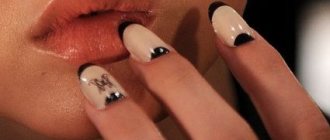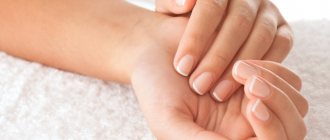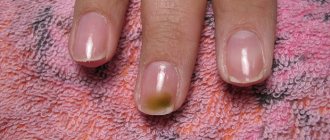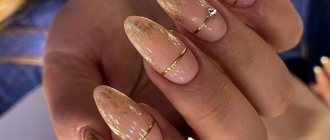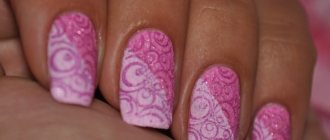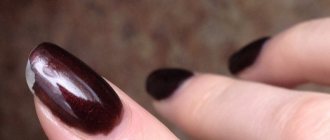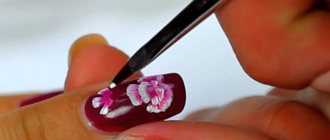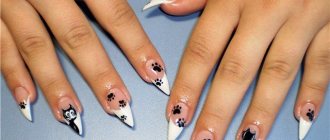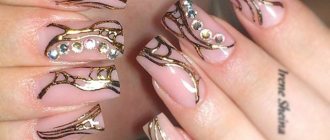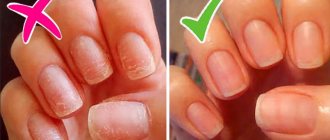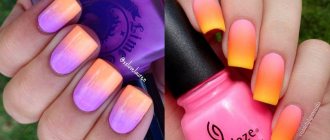Why do pits and holes appear on nails, what do they mean?
When the human body is in a balanced, healthy state, its nails should be pink, shiny and hard. Nutrition, environment, cosmetic care, physical, chemical and mechanical stress are important factors that affect the appearance of such troubles as pits on the nails. The manifestation of any health disorders is the same reason for a change in the appearance of nails, as is a change in any of the above elements in an unfavorable direction.
Transverse dents
The appearance of transverse dents on the thumbnail most likely indicate the presence of problems with the respiratory, that is, bronchopulmonary apparatus.
Holes
In cases where dots in the form of holes appear on the nails, a person wonders: what could it be? Very often, the presence of small holes and pores indicates a pathology of the spleen.
Pits
However, there is also the concept of “ thimble symptom ”, in which small dents appear on the nail - pinpoint “weariness”. The pits can be located one at a time randomly or in many “slender” longitudinal rows. The appearance of a dimple is possible both with psoriasis or dermatoses, and with systemic diseases, such as alopecia areata (the main symptom is the appearance of bald spots on the head).
Dents on nails and their causes (depending on the shape).
We will consider such serious reasons in more detail below.
Dimples
In medicine, there is a term called “thimble syndrome,” in which small dimples form on the nails. The nail seems completely pitted. They usually stand in rows or randomly scattered across the entire surface.
Such depressions indicate an emerging disease, such as psoriasis, dermatitis or some kind of systemic disease (if you have other symptoms, do not delay going to the doctor).
Nail self-diagnosis
You need to start diagnosing with the holes.
In the East, they believe that if a person has a missing hole on his thumb, this indicates mental problems.
The nail on the index finger signifies colon health. Its changes indicate diseases in the gynecological field.
If there is no hole on the middle finger, this means that the person may have problems with the circulatory system. With damage to the pituitary gland or neuroses of the heart, the holes may disappear. If you follow a healthy lifestyle, all the holes will return to their places, showing that your health is in perfect condition.
The nail of the ring finger indicates problems in the endocrine system.
An interesting feature is that the hole on the little finger disappears with age in some people. The nail on the little finger itself shows the condition of the heart and small intestine. Over the years it can become clogged with waste, and then the hole will simply disappear.
If your nails have small pits
, a dermatologist may suspect psoriasis (but this happens infrequently - only in 10% of those observed). But there are small holes and pores on the nails
indicate pathologies of the spleen.
Curved nails
indicate oxygen starvation, lung condition, and heart disease. In this case, a visit to the doctor and examination is mandatory. One of the signs of lupus is uneven red lines at the base of the nail. Melanoma is indicated by dark lines.
A healthy person's nails are often pink. Any deviations from the norm are a reason to check with a doctor and make sure that everything is in order with your health. If your nails are yellow and peeling
- it is possible that you have problems with your lungs. White color
indicates problems with the liver, red indicates problems with the heart.
White-pink nails
indicate possible kidney problems, while yellowish-blue nails may indicate diabetes.
If your nails are shiny
as if they were covered with clear varnish - it’s worth checking for hepatitis. Nails with a bluish tint may indicate a lack of oxygen. This leads to a huge chain of diseases, to the point where there may be fluid in the lungs.
White dots on nails
indicate that your body lacks essential vitamins. Sometimes pale color and brittleness of the nail plate are a sign of anemia, which means a lack of iron, and can also indicate problems with the metabolism of sugars in the body or drinking large amounts of alcohol.
Are your nails too red?
This may indicate that you have too many red blood cells in your blood. But pale nails, on the contrary, indicate anemia and disorders in the blood system.
If your nails are not growing well
or do not grow at all, be sure to visit an endocrinologist - these may be symptoms of problems with the thyroid gland.
Habit of biting nails
speaks of nervous system disorders, constant worries and gastritis.
A sign of bacterial endocarditis are stripes that look a little like splinters.
(actually these are small hemorrhages). Similar stripes can also appear due to trichinosis.
If your nails are brittle and brittle
, this may be the cause of a lack of minerals, hypovitaminosis and indicate your state of stress. The body signals you that it’s time to take care of yourself, relax, take a vacation and take a course of multivitamins.
The nail plate in healthy people is always smooth, but its ribbing
may indicate a wide range of diseases, for example, disorders of the cardiovascular or respiratory systems. It could also be a sign of anemia or a problem with the thyroid gland.
If you are 100% sure that you do not have any of the above diseases, but your nails still remain ribbed, it means that they lack keratin (the material from which the nail plates are made). It may also indicate a lack of vitamin B or moisture and oils.
Horizontal and vertical stripes
The disease is called leukonychia, and in some cases it is complemented by the formation of transverse and longitudinal tubercles. This is also a pathology that occurs due to disturbances in the process of keratinization of the nail.
Causes of horizontal or vertical white stripes:
- Exposure to extension materials during prolonged wearing of artificial plates;
- Cuts for hardware manicure;
- Damage to the growth zone or matrix during hardware or trimmed manicure, extensions;
- Diseases of the central nervous system;
- Hereditary predisposition;
- Age-related changes in the structure of the plates;
- Disturbances of the endocrine system;
- Cardiovascular diseases;
- Problems with blood circulation;
- Impaired metabolism, unbalanced diet;
- Fungus;
- Psoriasis;
- Stress.
If the cause is a disease, a doctor must diagnose it and select the appropriate treatment. The salon technician can recommend that the client undergo an examination and, for correction, use self-leveling varnishes and bases, biogel, structuring or camouflage gel under the coating.
At home, the same leveling systems will help to visually correct stripes or bumps - biogel, rubber base or dense gel polish, shellac. If you practice very strict diets, eat incorrectly and monotonously, then you will not be able to improve your nails with such care. Contact a nutritionist to help you adjust your diet.
Fungal infections
Infection with fungi can occur in public places - saunas, swimming pools, baths. At the same time, flip-flops do not always protect against infection. To make a diagnosis, a dermatologist takes a scraping from the nail plate. The type of fungus that caused the infection is determined in the laboratory.
Most often, this problem appears on the toenails. Outwardly it looks far from aesthetically pleasing, but pain with such an infection is rare. Fungus infection is also possible on the hands.
Complications and prognosis
With the development of nail melanoma, the risk of metastases is very high. As a rule, they appear in the liver and lungs. However, resection does not protect 100% from these processes.
Another difficulty is that surgery always (but to varying degrees) reduces the functionality of the limb. Patients also experience psychological difficulties, since their lifestyle changes, and in the case of hand operations, difficulties arise with the perception of their new appearance, which is difficult to hide from others.
In the absence of metastases, the five-year survival rate of patients is about 60%, but if metastases are already present, the average survival rate ranges from 7-8 months. The specific timing depends on individual characteristics, as well as the size, thickness of the tumor and other factors.
Proper nutrition
Peculiarities:
- To strengthen nail tissue, amino acids are needed; they make up the strong protein keratin. Minerals such as calcium, iron, phosphorus, silicon, chromium, selenium, zinc and sulfur are also extremely important. Sulfur atoms, for example, provide bonds between chains of keratin molecules, making nails strong and not prone to brittleness and delamination.
- To fully provide the body with nutrients, you need to include a variety of healthy foods in your diet.
- First of all, it is strictly not recommended to consume fried and fatty foods, sausages, and unhealthy sweets.
- Vegetables, fruits and herbs must be included in the menu. It is a storehouse of all kinds of vitamins and minerals.
- To prevent dehydration, adults must drink 1.5–2 liters of water per day, in addition to the rest of the liquid.
- Dairy products - cheese, cottage cheese, milk, yogurt, as well as greens - will help provide the body with calcium.
- It is recommended to eat cereals and wholemeal bread, since cereals contain a huge amount of vitamins B1, B2, B6, which are very beneficial for nails.
- Vegetable oils and nuts are sources of vitamin E, so they should be present in the diet.
- Do not neglect foods rich in omega-3 fatty acids. They are found in flaxseed oil, fatty fish, nuts and mangoes.
- To get iron and zinc into your body, it is important to regularly consume meat and offal.
- Collagen is essential for healthy nails, so you should include jelly, jellied meat and broths in your diet.
Take care of the health and hygiene of your body, and then your nails will delight you with beauty and impeccable appearance.
Dents or dimples on the nails can really scare anyone. In fact, if you have such problems, it is not necessarily bad (but not necessarily good either). There are many different reasons and factors that cause scratches and roughness to appear on smooth nail plates. Let's take a closer look at all the possible variants of this disease.
Fragility
With this problem, the plates can break in both the horizontal and vertical directions, leading to painful conditions. Brittle nails are thin, grow slowly and require constant care.
Causes of fragility:
- Excessive use of means to strengthen the plates;
- Illiterate care;
- Frequent extensions with cutting off the top layer;
- Constant contact with water and detergents;
- Contact with chemicals and solvents based on acids and alkalis that corrode the plate;
- Lack of vitamins A, D, E, calcium, selenium, zinc, iron;
- Gastrointestinal diseases, stress, anemia, diabetes.
In a salon setting, treatment with hot oil baths, massage, paraffin therapy, and the use of glass and ceramic nail files are recommended.
Before applying a decorative coating, it is necessary to apply a protective agent.
Hot manicure - how to do it, what products are needed
Strengthening nails with a rubber base, biogel, and extension gel is indicated. Cracks can be repaired with silk or fiberglass.
Lyudmila Sheveleva
Doctor, pharmacist
Ask a Question
A therapeutic massage of the nail plate and cuticle area using a keratin complex is useful. When polishing, be sure to use fortified creams or oils that seal the nails. If a deep crack has formed, contact your repairman immediately. Otherwise, pathogenic microorganisms can penetrate into it, provoking the development of an infectious-inflammatory process.
Fiberglass: what it is, application features, step-by-step techniques
To care for brittle plates at home, use hot oil and salt baths (maximum 10 minutes). Strengthening oil will help prevent brittleness and delamination. Apply it daily until problem areas grow back. And don’t forget to wear gloves when in contact with water, detergents and chemicals.
Line of Klavio lotions: instructions, indications for use, reviews
Lack of vitamins
Possible cause: vitamin deficiency! With vitamin deficiency, pits most often appear on the fingernails. However, in addition to this symptom, hair fragility or increased hair loss may be observed. The nail can “tell” which microelement is missing in the body. If the dent looks like a transverse groove and there are several of them on the plate, this indicates a lack of iron in the body.
Healthy nails
Your nails will be in good condition if you reduce their exposure to cosmetics or direct contact with household chemicals. Dishwashing liquid, washing powders and other chemicals damage your nails and skin.
Monitoring the condition of your nails is just as important as eating a balanced diet and leading a healthy lifestyle. If you still have reasons for concern, do not delay visiting a doctor. Don't miss the slightest change in the condition of your nail plates so that it doesn't develop into serious health problems.
Diagnosing dents, holes and other irregularities has been done with great accuracy since ancient times. At the same time, warning signs (for example, pits) on the nails appear long before changes in well-being and the appearance of primary symptoms of the disease; this knowledge will help us in resolving the issue of determining the causes of unevenness of the nail plates.
Mechanical damage
Damage to nails when removing gel polish or extension materials is one of the most common nail problems, which further leads to brittleness, splitting and peeling nails.
Causes of damage to nails with extension materials:
- Intensive cutting of artificial material with removal of part of the natural plate;
- Excessive removal of the natural shine of nails before extensions;
- The use of metal cutters for removing gel polish and gel. It is better to use ceramics, especially for beginners in hardware manicure;
- Tearing off gel polish and artificial nails from a natural plate;
- Incorrectly selected files and cutters for natural nails in terms of abrasiveness and size.
In salon conditions, the problem of nails that have been sawed and slightly damaged by abrasives is solved with the help of a leveling and strengthening coating - a rubber base, biogel, gel or acrylic.
Hardware manicure - answering frequently asked questions
Craftsmen should follow the manufacturers' recommendations for each material and tool used to avoid possible damage to the plates. It is better to remove artificial coating and gel polish by soaking or filing with ceramic cutters with a blue notch. This should be done with smooth movements without intense pressure, at speeds of 6,000-10,000.
At home, damaged or filed nails are treated with restorative oils and strengthening coatings.
Hand baths: 30 recipes for different purposes
Injuries, chemical exposure
Regular exposure to chemicals can lead to nail diseases such as onychochigis or onychoya, the symptoms of which can also be the nail pits. The disease leads to dystrophic changes in the body, in particular, to the splitting of the nail plate into transverse elements in the form of small leaf-shaped plates.
The reasons mainly lie in the exposure of nails to chemicals during the performance of professional duties. The disease is common among chemical industry workers and medical workers who come into contact with disinfectant solutions. However, excessive use of varnishes together with products containing acetone for its removal sometimes leads to the development of this health disorder.
The constant use of detergents and disinfectants in household use only aggravates this process.
Onychoschisis is also a disease that develops due to constant mechanical stress on the nail plate. Recently, IT workers are susceptible to this disease because they constantly type a large amount of information manually. So frequent communication via a computer may not be a harmless activity.
Causes of curvature of the nail plate
Healthy nails have a smooth, shiny, soft pink surface. If the nail plate becomes rough, growths or pits appear on it, the nail turns yellow, splits and breaks, all this may indicate diseases in the body.
The causes of curvature of the nail plate can be:
- Diseases of internal organs.
- Injury due to negligence.
- Low hemoglobin levels and the development of anemia.
- Strong medications (antibiotics) or a course of chemotherapy.
- Genetic pathologies that lead to dystrophy of the nail surfaces.
- Infectious diseases caused by fungi and bacteria.
- Psoriasis.
- Poor quality and uncomfortable shoes.
The first reason for the curvature of the nail plate is improper care. Untimely removal of dirt from under the nails or fanatical cleaning of them leads to damage to the skin of the fingers and the proliferation of bacteria, which results in the development of nail diseases.
Using household chemicals without protective equipment leads to deformation of the nail plate, since detergents and cleaning compounds can destroy its structure.
Fungal infections
Fungal infections are the most common and hold the lead among the causes that cause curvature of the nail plate on the fingers. When the first signs of nail fungus appear, it is necessary to urgently consult a specialist and receive qualified treatment, since self-therapy does not give effective results and often leads to the development and spread of the disease. It should be noted that curvature of the nail plate is not a sign of fungal infection.
The fungus not only causes deformation of the nail plate, but also provokes the formation of growths and thickenings on it. The surface of the nail becomes loose, flakes and peels, and as the disease progresses it turns yellow or black, and in advanced cases an unpleasant odor appears.
The development of pathology in the initial stages may be accompanied by peeling and redness of the skin around the infected nail. With early diagnosis, treatment is most effective, so curvature of the nail plate may not occur. From this it follows that nail deformation is a consequence of the long-term development of a fungal disease.
Injury
Mechanical damage can lead to curvature of the nail plate.
Trauma, cuts or other mechanical impacts cause deformation of the nail plate. Severe damage to the matrix and lunula can lead to peeling of the nail. Such injuries cause acute pain, and in some cases require the help of a surgeon. Injury to the nail plate on the hands can occur even during the process of performing a manicure due to incorrect and careless actions.
Psoriasis of the nail plate
One of the reasons for the curvature of the nail plate on the hands can be psoriasis. With this disease, the patient experiences nail detachment, discoloration, and damage to the surrounding skin. If psoriasis affects the toenails, then suppuration and thickening of the nail plates often form, and a characteristic striped pattern appears on their surface.
Onychotillomania
Onychotillomania is a mental disorder that is expressed in a person’s conscious desire to independently destroy the nail plate. This disease is often diagnosed in people with a psychopathic personality. With onychotillomania, a person is overcome by delusional ideas, as a result of which he injures his nails mechanically, trying to eliminate the microbes that are under them. To treat this type of curvature of the nail plate, you should seek help from a psychiatrist or psychotherapist.
Recommended articles on the topic:
- Medical hardware pedicure
- How to strengthen peeling nails
- Removing an ingrown toenail and how to avoid it
Treatment
If dents appear on the nail plates, it is strongly recommended to find out from your doctor the cause of their occurrence . A competent specialist will select a treatment that will smooth the surface of the nails and improve their appearance.
Eliminating unevenness in the nail plate will not be difficult if you plan your diet correctly, as well as understand the cause of their occurrence and follow the prescribed treatment.
Successful treatment of the underlying disease allows you to eliminate uneven nails completely:
- if fungus or psoriasis is present, the help of a dermatologist is required;
- if lung diseases are detected, you need to consult a pulmonologist;
- patients with heart pathologies are treated by a cardiologist;
- If there is a lack of vitamins in the body, you should consult a therapist, who will prescribe medications and adjust the patient’s diet.
To reduce the depressions on your nails, experts recommend using polishing files. The tool should be moved only in one direction, do not press too hard, movements should be neat and soft. To smooth the surface of the nail and make the dimples almost invisible, several polishing procedures should be performed.
Peeling
There are external and internal factors that provoke nail detachment. The medical name of the disease is onycholysis. When affected by an infectious genesis, the nail becomes cloudy and rough. It is possible to completely get rid of onycholysis only in 30-40% of cases.
Causes of onycholysis:
- Damage, explosion;
- Incorrectly selected shoes;
- Cuts;
- Peeling and chipping of extended materials, which “pull” the natural plate along with them;
- Failure to comply with the technology of extensions and coating with gel polish and other long-term materials;
- Excessive wear of artificial turf, untimely correction;
- Human papillomavirus;
- Cardiovascular and endocrine diseases;
- Fungus and bacterial infections;
- Psoriasis;
- Eczema;
- Allergy.
In a nail salon, the master corrects the peeling by removing the free edge and performing extensions with artificial material (if the reason is that the coating is worn out).
The edge of the detachment cannot be undermined further. If the condition is severe, refer the client to a doctor. He must select medications, including those for internal correction of the balance of vitamins and minerals. In case of severe detachment, surgical intervention and the use of dressings with antibacterial and antiseptic solutions are required. Long-term use of gelatin solutions of various concentrations has proven itself to be effective in nail restoration.
The client may need to undergo treatment for fungal and bacterial infections, which should not be sealed under a layer of artificial turf to avoid exacerbating the problem. At home, you should not undermine the source of exfoliation; you should consult a doctor if there is a hint of fungus or infection, cut your nails short and wear protective gloves when working at home. For feet - choose comfortable shoes.
Nail psoriasis
Pits on the fingernails (with psoriasis).
In patients with this disease, only the nails are rarely affected. Usually other parts of the body are also affected - very often the skin, sometimes the bones.
Symptoms can be different, the main ones are:
- the color of the nails becomes yellow with brown tints;
- holes (small depressions) appear on the nail plate;
- horizontal lines (transverse dents) and white spots appear on the fingernails;
- plate thickenings form;
- the nail plate may separate from the bed.
Many patients are interested in how to get rid of psoriasis. The answer is clear - it is impossible. However, it is possible to cope with the symptoms with the help of ointments and injections, which the doctor can select (individually for you).
What do longitudinal grooves mean?
If transverse dents appear on the nail plates of your hands, in most cases this means that you have problems with the respiratory system, or more precisely with the bronchi or lungs.
With this type of dent, it is better to immediately contact a specialist. Excessive caution never harmed anyone.
What to do, how to treat
Symptoms consisting of the appearance of various dents, grooves, pits and depressions on the nails are possible due to completely different reasons. Some require only a little effort to heal, while others may take the rest of your life to heal:
- Infections. To prevent fungal diseases, baths with the addition of lemon juice or vinegar are used. Treatment of fungal infections is not a quick matter, since the penetration of drugs in the form of ointments through the nail plate takes a long time. Comprehensive treatment, including tablets, ointments and vitamins, brings the greatest effect. ⇒ For more details, see the articles about antifungal varnish, tablets for nail and skin fungus, iodine against nail fungus.
- Vitamin deficiency can be compensated for by taking vitamin complexes orally and restoring a balanced healthy diet. It is necessary to have less contact with detergents and washing powders. The most effective methods of nail restoration can only be found together with your doctor.
- The chemical effect on the nail plate can only be restored with complex treatment. It is necessary to restore minerals and vitamins in the body. Vitamin injections and tablets are also prescribed.
- Nail psoriasis. For this disease, treatment is carried out using traditional therapy or phototherapy, and surgery is also possible to remove deformed nail plates. Instead of the latter, medications with urea compounds can be used, which allow the nail to separate from the bed without surgery. The drugs used can be either external use, directly applied to the nail, or internal or in the form of injections. A defect in the nail plate can hide a manicure.
Prevention
After successful removal of white spots, it is recommended to regularly carry out preventive maintenance in order to avoid the recurrence of defects in the future. Timely rest, healthy sleep, and nutrition without strict restrictions have a positive effect on the health of nails. To prevent the appearance of stains, you can use soothing baths with natural ingredients (lemon, salt, honey, soda, essential oils, herbal infusions). In addition, prevention of leconychia involves:
- compliance with the rest and work regime;
- timely diagnosis and treatment of somatic diseases;
- exclusion of alcohol, smoking;
- use of protective equipment when working with chemicals;
- careful manicure;
- compliance with personal hygiene rules.
What causes dents?
There can be many reasons for the appearance of dents on nails - from ordinary damage on a hard surface to a serious systemic disease that needs to be treated urgently.
Most people develop dents due to mineral deficiencies.
This problem can be easily solved by simply changing your diet to one richer in nutrients, minerals and vitamins. You also need to take care of your hands.
If after changing your diet the problem does not disappear, the problem is different. Rough nails indicate that you need urgent medical consultation.
Hangnails and periungual skin cracks
Hangnails are tears in the skin of the cuticle and nail folds. They cause pain, discomfort, often bleed and are not aesthetically pleasing.
Neglected hangnails lead to the appearance of periungual skin cracks and are a source of penetration of bacterial and fungal infections with subsequent inflammation.
Causes of burrs:
- Dry skin and plates;
- Frequent contact with water and chemicals;
- Sensitive skin;
- Nail biting (onychophagia);
- Improper cutting of cuticles, blunt manicure instruments;
- Weathering and changes in ambient temperature in the off-season;
- Working with various chemicals without gloves;
- Poor hand hygiene;
- Use of low-quality nail polishes, acetone-based liquids;
- Use of materials with methyl methacrylate for nail extensions;
- Unbalanced nutrition, diet, fasting;
- Diseases of the gastrointestinal tract;
- Dysbacteriosis;
- Diabetes.
In a salon setting, the master will benefit from hot oil bath procedures, as well as cold or hot paraffin therapy.
Paraffin therapy for hands - what is it, benefits and step-by-step instructions
At home, wear protective gloves, apply nourishing oil to the cuticle twice a day, make masks with nourishing and protective cream under polyethylene or silicone mittens at night. And be sure to drink at least 2.5 liters of fluid, of course, if you have no contraindications.
